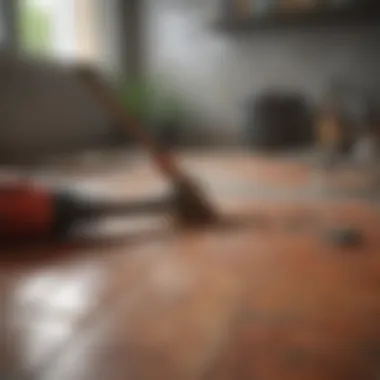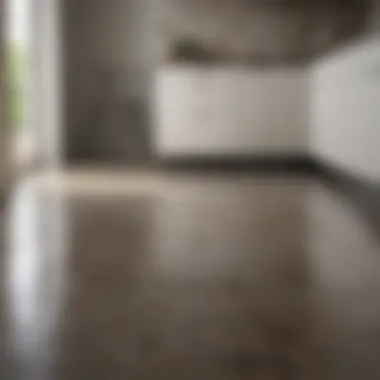Comprehensive Guide to Removing Kitchen Tiles


Intro
Removing kitchen tiles can be a daunting task for many homeowners. Whether you are upgrading for better aesthetics or addressing damage, understanding the techniques involved is crucial. This guide emphasizes the importance of specific preparations and choosing the right tools, ensuring that the process goes as smoothly as possible.
In this article, we will explore the various types of tiles commonly found in kitchens, the challenges you may face during removal, and how to protect the underlying surfaces. By following our methods, both beginners and seasoned DIY enthusiasts can approach the project with confidence.
Key Insights and Trends
Current Tile Trends in Interior Design
The kitchen is often regarded as the heart of a home. As such, design trends evolve regularly. Currently, subway tiles remain popular for their timeless appeal. Additionally, the rise of large-format tiles offers a minimalist aesthetic that many homeowners favor. These trends influence the decision-making process when considering removing tiles. Know that the type of tile directly impacts the removal strategy.
Maintenance and Repair Considerations
There is more to tile removal than just aesthetics. Understanding the condition of existing tiles can save time and money. For instance, if tiles are cracked or loose, they may require careful removal to prevent further damage to the substrate.
Practical Tips and How-To Guides
Step-by-Step Guides for Tile Removal
- Gather Supplies: Essential tools include a chisel, hammer, pry bar, and safety glasses. If your tiles are glued, a heat gun can also be useful.
- Prepare the Area: Clear the space thoroughly. Remove appliances and furniture to prevent damage during removal. Cover nearby surfaces with drop cloths for extra protection.
- Test a Tile: Identify a starting point by testing a single tile. Use the chisel and hammer to see how easily it comes off. This will guide your technique for others.
- Begin Removal: Shift the chisel's edge beneath the tile while applying gentle force. If tiles are stubborn, apply heat using the heat gun for a few seconds before trying again.
- Clean Up: Once tiles have been removed, ensure the surface underneath is clean. Use a putty knife or a scraper to remove any glue remnants.
Ensuring Underlying Surface Integrity
It’s vital to examine the condition of the subfloor after tiles are removed. Look for signs of water damage or mold. Proper maintenance at this stage can prevent costly repairs later.
"Always preserve the integrity of the underlying surface to avoid unexpected expenses in the future."
The End
Each step in removing kitchen tiles requires careful attention to detail. By understanding current trends and being equipped with practical knowledge, homeowners can ensure a successful renovation while mitigating potential pitfalls.
Prologue to Tile Removal
Removing tiles from your kitchen may seem like a daunting task, but understanding the reasons behind tile removal can greatly facilitate the process. There are several motivations that might lead a homeowner to undertake such a project. From wanting to modernize the aesthetic of the kitchen to addressing damage beneath the existing surface, each purpose carries its own significance.
Purpose of Tile Removal
The primary purpose of tile removal can vary from person to person. For some, it is aesthetic improvement—outdated styles may clash with new decor or preferences. For others, it’s about necessity; perhaps tiles are cracked or moldy, potentially compromising the safety and health of the household. Additionally, tile removal sets the stage for renovations or the installation of new tiles, contributing to an enhanced functionality within the kitchen space.
"The act of removing tiles should not simply be viewed as a chore; it can be an opportunity to breathe new life into your kitchen."
Overview of the Process
The process of tile removal generally follows a structured approach that streamlines the experience and minimizes stress. The initial phase involves proper assessment of the existing tile type and understanding the necessary tools. Thereafter, protective measures are implemented to ensure the surrounding environment remains undisturbed throughout the process.
Once the setup is in place, the actual removal involves various techniques, from breaking grout seals to carefully loosening and taking out tiles. It’s crucial to stay organized throughout the entire process, maintaining a methodical approach to avoid damage to underlying structures. By preparing adequately, the risk of complications and additional repair work post-removal is significantly reduced.


This foundational knowledge lays the groundwork for realizing a successful tile removal project, allowing homeowners to achieve results that align with their renovation goals.
Preparing for Tile Removal
Preparing for tile removal is a crucial step that can significantly influence the overall success of the project. Without proper preparation, the process can become messy and time-consuming. Tile removal involves not only the physical act of removing the tiles but also understanding the type of tile being dealt with, gathering the right tools, and protecting the surrounding environment. Being well-prepared helps to avoid potential damage to the substrate beneath the tiles and other surfaces in the kitchen.
Assessing the Tile Type
Identifying the type of tile is essential for effective removal. Different tiles respond to removal techniques differently. For example, ceramic tiles tend to be more brittle and can break easily, while porcelain tiles may need more effort to loosen due to their density. Additionally, if the tiles are natural stone, special care is needed to avoid chipping or damaging the edges.
Checking for the tile's size and thickness also plays a role in your approach. Thicker tiles require more force, while thinner tiles might come off with less resistance. Knowing these characteristics enables you to tailor the removal method.
Gathering Essential Tools
Safety Gear
Safety gear is an important element in tile removal. This equipment typically includes safety glasses, gloves, and a dust mask. Wearing safety glasses protects your eyes from sharp fragments, while gloves prevent hand injuries. A dust mask is crucial since tile removal creates a considerable amount of dust and debris, which can harm your respiratory system. These items not only ensure personal safety but also foster a focused work environment.
Removing Tools
Removing tools are the backbone of any tile removal job. Essential tools include a chisel, hammer, and potentially an oscillating tool or tile removal tool. These tools help to break the grout seal and loosen tiles effectively. For example, the chisel allows for precise removal without damaging surrounding tiles. The oscillating tool can speed up the process greatly by cutting through tough adhesive or grout. Properly chosen removing tools make task execution smoother, reducing the risk of unnecessary work injuries.
Cleaning Supplies
Cleaning supplies play a significant role after the tiles are removed. Once the tiles are up, residue and debris will remain on the surface. Having cleaning supplies such as a vacuum, mop, or all-purpose cleaner is advantageous. This ensures you can clean the space immediately after removal. A tidy workspace minimizes hazards and sets the stage for any future renovations or installations. It is a beneficial choice to invest in good cleaning supplies, as neglect can lead to issues down the line.
Protecting Your Space
Protecting your space is just as essential as the actual tile removal process. This step ensures your kitchen and adjacent areas suffer minimal damage during the operation. Covering floors and protecting cabinets can prevent scratches, dents, and other forms of damage.
Covering Floors
Covering floors with protective sheeting will catch any debris falling from above. This can be as simple as using old sheets, tarps, or drop cloths. Using this extra layer of defense benefits the cleaning process, catching dust and tile pieces that would otherwise settle on your floors. This not only reduces cleanup time but also protects your flooring investment.
Protecting Cabinets
Protecting cabinets is necessary to avoid scratches or dings that might result from tools or debris. Using painter's tape to cover edges or applying a protective plastic film helps to preserve the finish of the cabinets. A small effort to guard against potential damage goes a long way in maintaining your kitchen's aesthetic appeal. By taking these precautions, you maintain both functionality and beauty in your kitchen space.
Step-by-Step Tile Removal Procedures
The process of removing kitchen tiles can be daunting for many homeowners or DIY enthusiasts. However, understanding the step-by-step procedures simplifies the task significantly. This section guides you through essential methods necessary for effective tile removal. Each technique not only aids in understanding the mechanics behind the removal but also lays a solid foundation for retiling or surface preparation afterward. Properly executing these steps minimizes the risk of damaging underlying surfaces and enhances the overall efficiency of the project.
Breaking the Grout Seal
The first step in removing tiles involves breaking the grout seal. Grout serves to bind tiles together, filling gaps and creating a seamless appearance. To effectively remove tiles, it is crucial to break this bond to allow the tiles to loosen without damage. A grout saw or a utility knife is often used for this task.
Care must be taken, as aggressive cutting can cause damage to the edges of adjacent tiles. Once the grout is sufficiently removed, it will create space for detachment, aiding in the overall tile removal process.
Loosening the Tiles


With the grout seal compromised, the next phase is loosening the tiles themselves. This step is pivotal as it determines how easily the tiles can be lifted from the surface. Various tools can be utilized, including a pry bar or flathead screwdriver. It is important to start at the edge of the tile and gently work your way inwards.
By applying even pressure, you can minimize the risk of breaking the tiles. Take your time during this step. Rushing can lead to cracks that complicate subsequent removal efforts.
Removing the Tiles
Using a Chisel
Using a chisel is a methodical approach for tile removal. The chisel can help to tap under loose or damaged tiles for effective leverage. It provides precise control over the removal process, ensuring that you do not damage surrounding tiles or the underlying surface. The key characteristic of using a chisel is its sharp edge, which can slide under tiles effortlessly.
While the chisel is beneficial due to its precision, it does require consistent tapping with proper technique to avoid breakage.
Using a Hammer
A hammer complements the chisel perfectly in tile removal. Once the chisel is positioned, a gentle tap with the hammer provides the necessary force to lift the tile. The coordinated effort of using both tools increases the success rate of tile removal. A hammer’s weight helps in applying greater force without needing excessive strain on the wrist or hand.
However, care must be taken not to hit too hard, which could lead to damage on overlapping tiles or surfaces. A steady hand and consistent force are key to a successful removal using this technique.
Tile Puller Techniques
Tile pullers are specialized tools designed for the removal of tiles without damaging the underlying structure. They work by gripping the tile and applying force uniformly across its surface, promoting easier removal. This method is particularly advantageous when dealing with many tiles or larger formats.
The standout feature of tile pullers is their efficiency in handling tougher tiles bonded with strong adhesives. However, the downside includes the potential for maneuvering issues in tight spaces. Proper technique is essential to maximize the effectiveness of tile pullers without risking damage to the surrounding area or the tile itself.
Managing Difficult Areas
Dealing with challenging sections during tile removal can impact the overall success of your project. Difficult areas typically include border tiles, tight corners, and areas with strong adhesives. Understanding how to manage these zones ensures that you do not damage the surrounding surfaces and facilitates a more efficient removal process. Moreover, proper handling of these problematic spots may save you time and reduce the risk of needing repairs afterward.
Removing Border Tiles
Border tiles are often set at the edges of a tiled area. These tiles may be installed differently than the main tiles, making their removal unique. To remove border tiles, begin by assessing how they are affixed to the underlying surface. If they are bonded with a strong adhesive, it might require more effort compared to standard tiles.
- Begin by scoring the grout between the border tile and adjoining tiles carefully.
- Next, use a chisel or a flathead screwdriver positioned at a slight angle to pry the border tile up.
- Take care to not apply too much force which can result in broken tiles or damage to the surface below.
Achieving a clean removal reduces visible gaps or uneven surfaces when preparing for new tiles.
Handling Adhesive Challenges
Handling adhesives is one of the more daunting aspects of tile removal. Various types of adhesives can complicate the process, and understanding their characteristics can help navigate these issues more effectively.
Types of Adhesives
Different adhesives are used depending on the tiles and the humidity of the area. Common types include thin-set mortar, mastic adhesive, and epoxy. Each has unique properties:
- Thin-set mortar: A cement-based adhesive used for most ceramic, porcelain, and stone tiles. Its strength makes it suitable for floors but can be difficult to remove.
- Mastic adhesive: Water-based and often used for wall tiles. It is easier to scrape off but can weaken in humid conditions.
- Epoxy: This strong adhesive is used for high-traffic or moisture-prone areas. Its removal often requires specialized techniques.
Understanding the type of adhesive you’re dealing with can help dictate the method you use for removal.
Scraping Techniques


Scraping is crucial when it comes to handling leftover adhesive after tile removal. This process involves using a scraping tool to gently chip away the residue. Effective scraping requires patience and the right tools.
- Start by softening the adhesive, if needed, using a heat gun or a solvent.
- Utilize a sturdy scraper designed for tile removal to lift the adhesive off the surface.
- Be cautious not to gouge the underlying material.
Using scraping techniques can minimize the effort involved in preparing your surface for the new tile installation. It's important to ensure that the underlying structure is clean for proper adhesion of new tiles.
Post-Removal Considerations
After the strenuous task of removing kitchen tiles, a few vital post-removal considerations can ensure the success of your project. These steps help maintain the integrity of the underlying surface and prepare for future installations. Ignoring them may lead to complications and extra work later on. Thus, understanding these aspects is crucial for both effective renovations and enhancing the longevity of your space.
Cleaning the Surface
Once the tiles are removed, the site often appears chaotic. It is essential to clean the surface thoroughly. Excess adhesive, grout remnants, and debris can create uneven surfaces or damage new tiles if not addressed.
start by sweeping the area to remove loose particles. After this, use a putty knife or scraper to eliminate any large pieces of adhesive. A solution of warm water and a mild detergent can assist in breaking down stubborn residues.
Consider allowing the cleaned area to dry completely. Moisture can impact future tile adhesion and create issues with mold or mildew over time.
Assessing the Underlying Structure
Assessing the underlying structure serves to inform what work still needs to be done. It involves both checking for damage and preparing for new installations.
Checking for Damage
When checking for damage, examine the subfloor for any soft spots, cracks, or signs of water damage. These issues can compromise the stability of the new tiles.
The key characteristic of this phase is that it helps in recognizing issues that could worsen with time. Detecting damage early allows for prompt repairs, ensuring a solid foundation for your new tile installation.
The unique feature of checking for damage is that it often requires a keen eye. Tools like a moisture meter can help you identify hidden problems that are not immediately visible. Ignoring this can lead to increased expenses the moment problems arise later.
Preparing for New Tile Installation
Preparing for new tile installation is the next crucial step. This phase emphasizes ensuring the surface is level and clean. A well-prepared area promotes better adhesion and overall longevity of the new tile.
The key characteristic of this preparation is to create a stable and clean area for new tiles. This is a popular choice since a properly readied surface can significantly reduce the risk of future issues like uneven tiles or cracking.
A unique feature of preparing for new tile installation is incorporating self-leveling compounds if necessary. These compounds fill low spots and ensure a flat surface. However, applying them requires certain skills, so improper usage can lead to more harm than good. It is vital to follow instructions closely and have patience during this process.
"Effective post-removal actions can significantly influence the success of your new installation."
Finale
The conclusion serves to encapsulate the insights shared throughout this guide on tile removal. The process of removing tiles is not simply a task of destruction; it is a careful engagement that requires knowledge, the right approach, and the proper tools.
Final Thoughts on DIY Tile Removal
Removing kitchen tiles can be a daunting task, but it can also be rewarding. Understanding the methods and techniques can increase confidence. The benefits of successfully completing a DIY tile removal project include saving money, customizing the kitchen space, and gaining a sense of accomplishment. However, one must consider time investment and the possibility of complex challenges. Not all tiles come off easily, and readiness to face unexpected issues is crucial for any DIY project.
Resources for Further Learning
For those eager to deepen their understanding of tile removal or general DIY renovation, a wealth of resources exists. Websites like Wikipedia and Britannica provide foundational knowledge on home improvement. Community forums such as Reddit also serve as excellent platforms for exchanging experiences and seeking advice. Additionally, tutorials on platforms like Facebook can provide visual guidance, enhancing the learning process.
"Every great DIY project begins with careful planning and the right information."
Engaging with these resources can provide valuable insights and updates on best practices, making future renovations smoother and more effective.



